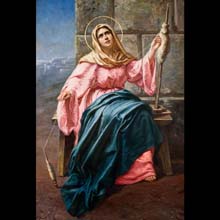
material: oil on canvas
dimensions: 197 × 132 cm
description: “New ideas will always fit in with what is already in existence in the range of iconographic motifs because the artist’s point of view changes with time”– said Władysław Łuszczkiewicz, a teacher at the School of Fine Arts in Krakow for many years, in the manifesto entitled Jakie są zasady malarstwa religijnego [The Principles of Religious Painting]. This painting genre presented at exhibitions could serve slightly different purposes than cult pictures destined for altars in churches. In such works, artists expressed new values and ideas characteristic of 19th-century religiousness. Works by Ernest Renan emphasized the human dimension of the figure of Christ, and a tendency of rendering grand academic subjects in the way similar to genre scenes affected also religious painting. The representations of God and saints resembled pictures showing the life and activities of ordinary people. The painting Our Lady the Spinner serves as an example of such compositions. Although the artist painted a halo surrounding Mary’s head, her hands are busy with the typical female work of the day – spinning. He added a new meaning to an old, medieval subject – Mother of God spinning a dress for Christ, namely a blessing for the quiet, humble work of women, who should follow the example of Mary, committed to God’s will. The title makes the picture an allegory of work sanctified by the divine figure. Barbara Ciciora
exposition: The Gallery of 19th Century Polish Art in Sukiennice,
The Cloth Hall, 1, Main Market Square
key: Around the academy >>>
dimensions: 197 × 132 cm
description: “New ideas will always fit in with what is already in existence in the range of iconographic motifs because the artist’s point of view changes with time”– said Władysław Łuszczkiewicz, a teacher at the School of Fine Arts in Krakow for many years, in the manifesto entitled Jakie są zasady malarstwa religijnego [The Principles of Religious Painting]. This painting genre presented at exhibitions could serve slightly different purposes than cult pictures destined for altars in churches. In such works, artists expressed new values and ideas characteristic of 19th-century religiousness. Works by Ernest Renan emphasized the human dimension of the figure of Christ, and a tendency of rendering grand academic subjects in the way similar to genre scenes affected also religious painting. The representations of God and saints resembled pictures showing the life and activities of ordinary people. The painting Our Lady the Spinner serves as an example of such compositions. Although the artist painted a halo surrounding Mary’s head, her hands are busy with the typical female work of the day – spinning. He added a new meaning to an old, medieval subject – Mother of God spinning a dress for Christ, namely a blessing for the quiet, humble work of women, who should follow the example of Mary, committed to God’s will. The title makes the picture an allegory of work sanctified by the divine figure. Barbara Ciciora
exposition: The Gallery of 19th Century Polish Art in Sukiennice,
The Cloth Hall, 1, Main Market Square
key: Around the academy >>>












